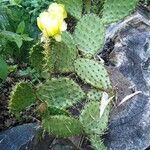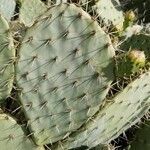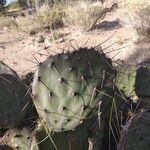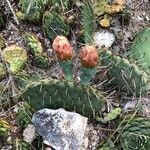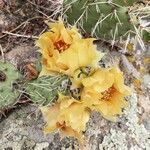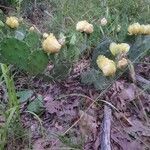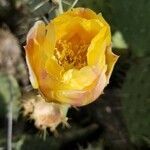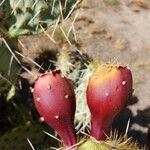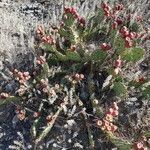Shrubs, decumbent to commonly trailing, 0.3-1 m. Stem segments not disarticulating, green to dark green, sometimes reddish under stress, flattened, obovate to circular, 10-25 × 7-20 cm, low tuberculate, glabrous; areoles 5-7 per diagonal row across midstem segment, obovate to elliptic, 3-6 × 2-4 mm; wool tan to brown, aging grayish. Spines (0-)2-8 per areole, at most areoles to only distal 1/4 of stem segment, or essentially absent, brown to white, straight, curved, or spirally twisted; major central spines deflexed or spreading, brown to red-brown (to blackish), or partly to wholly gray to tan, subulate, usually flattened near base, 30-80 mm; abaxial spines usually 1-3, deflexed, white, flattened, shorter, to 20 mm. Glochids dense in crescent at adaxial edge of areole and subapical tuft, tan to red-brown, to 5 mm. Flowers: inner tepals yellow with red basal portions (rarely entirely pink to red), 30-40 mm; filaments greenish basally, pale yellow to white distally; anthers yellow; style white; stigma lobes green to yellow-green. Fruits wine red to purple, with greenish flesh (sometimes reddish and ± juicy), not long stipitate, obovate to barrel-shaped, 30-50 × 20-30 mm, fleshy, glabrous, spineless; areoles 18-24. Seeds tan, subcircular, 4-5 mm diam., evidently notched, warped; girdle protruding 1 mm. 2n = 66.
More
A cactus. It is a sprawling shrub. It grows 30-90 cm high and spreads 1.2 m wide. The stem segments are flattened. They can be 38 cm long. There are fierce 6 cm long spines in clusters. The flowers are bright yellow and can be red within. The fruit are pear shaped and purple-red. They are 8 cm long.
Dry prairies and open woodlands, often on sandy soils. Grasslands, pine-juniper woodland, xerophyllous scrub and chaparral, in sandy or rocky soils of hills, flats, valleys, it also grows on cliffs and canyon walls.
More
It is a subtropical and tropical plant. It suits hardiness zones 9-11.
The stem segments are roasted. The fruit are eaten raw, dried, pickled or made into jelly. They are also baked with sugar, butter, lemon juice and cinnamon. The seeds are dried and parched and ground into meal and used in gruel or cakes. The young stems are boiled or roasted and eaten with scrambled eggs.
